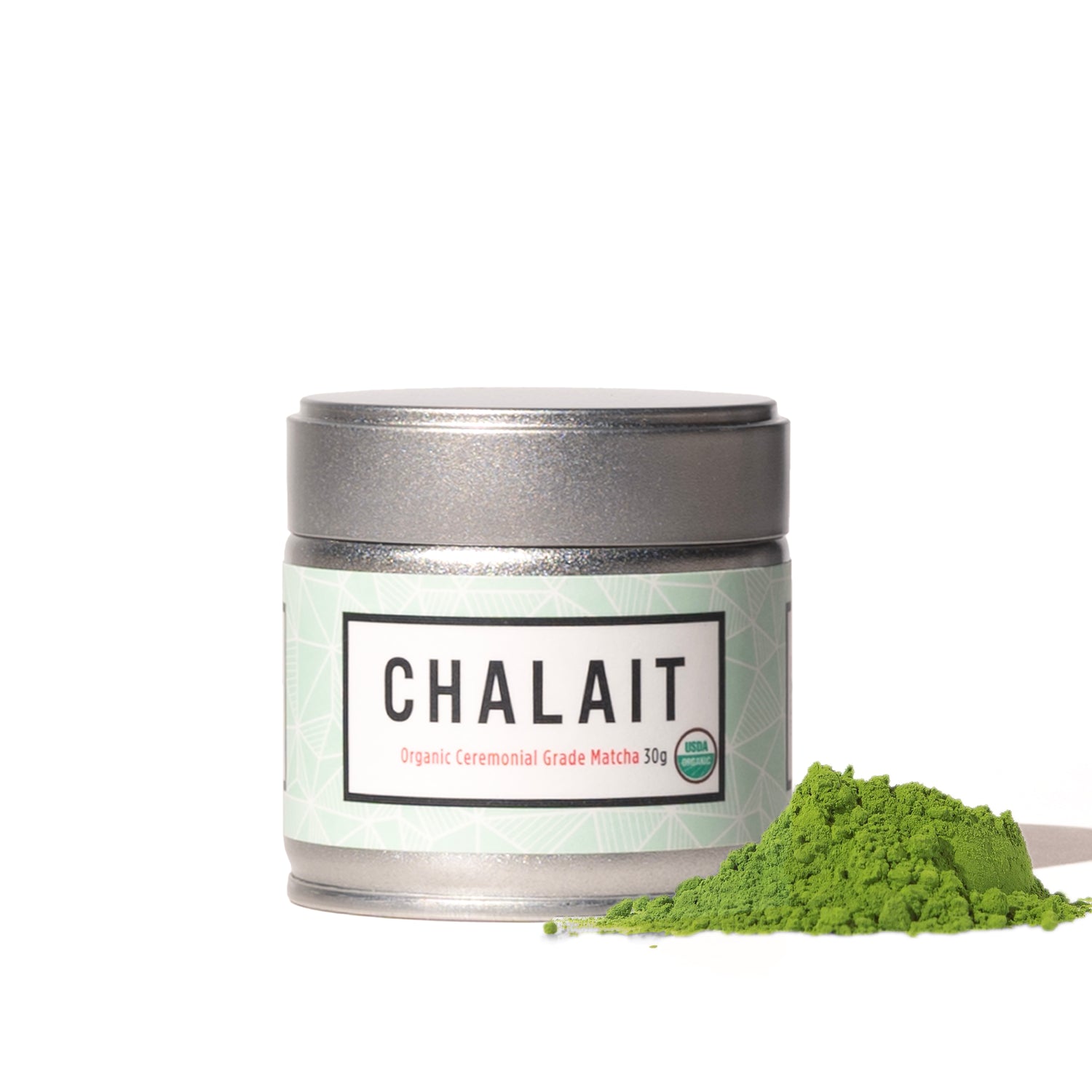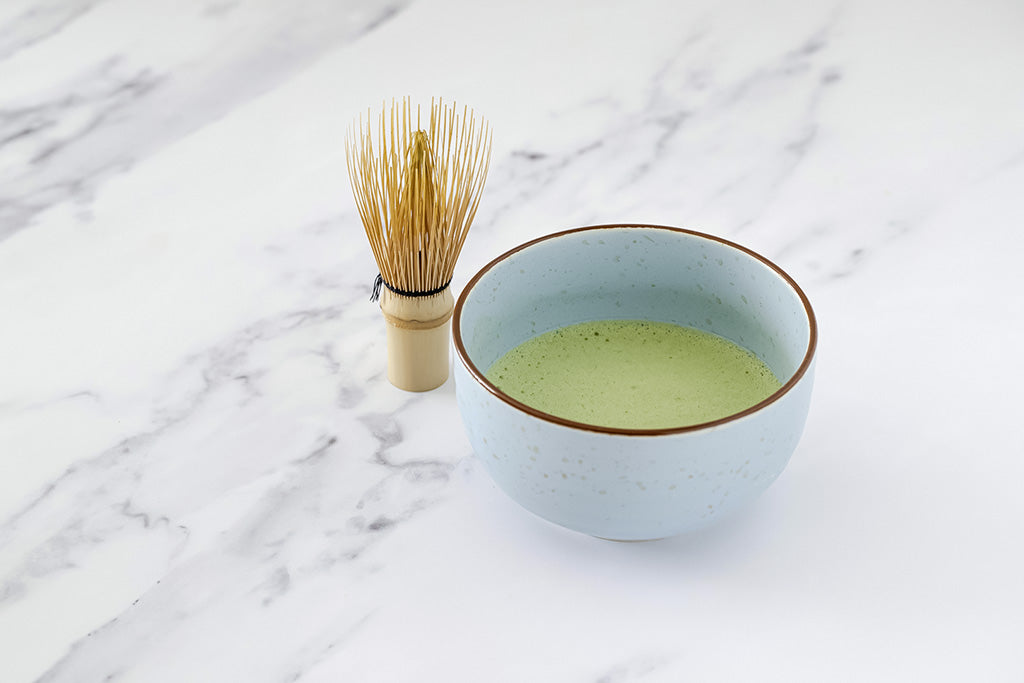Matcha contains many beneficial compounds. Some of them are already well known, and others may be rarely mentioned. Still, they all contribute to the delicious flavor and its many benefits. What are they? What’s in matcha tea?
Let’s delve deeper into the composition of this unique tea.
What is matcha?
Matcha is a unique type of shaded Japanese green tea in a powdered form. Although any tea can be powdered, not every tea will be matcha. There are several factors that make it so unique:
- Terroir
- Tea plant cultivar
- Shading process
- Harvesting times
- Removing stalks and veins
- Powdering
Each of these factors will impact the leaf composition and the total amount of beneficial compounds.
Some of the most important compounds in matcha include caffeine, catechins, chlorophyll and L-theanine. These compounds will provide the most benefits. There are many others that may offer benefits too but didn’t get enough of the spotlight just yet.

Let’s start with the most well-known ones – caffeine, chlorophyll, L-theanine and EGCG.
Caffeine
When tea started gaining in popularity, many sources reported that caffeine in tea, and especially in matcha, differs from caffeine in coffee. It was implied that caffeine in tea was called theophylline or theine. However, theine and caffeine are the same compounds, the only difference is the name. Caffeine is the word that was used when talking about coffee, and theine was the word used when talking about tea. Today, that gap is closed, and we mostly talk about caffeine only.
Caffeine is a methylxanthine, and so is the theophylline. Both can be found in coffee and tea. Theobromine is another methylxanthine that is present in coffee, tea, and cocoa beans. However, studies showed that the amount of theophylline in matcha or other teas in negligible. Furthermore, the amount of theobromine is much lower than in black teas [1].
The energy boost that matcha may provide, therefore, comes from caffeine. So why is it different from caffeine in coffee? The answer is in L-theanine.
L-theanine
L-theanine is an amino acid that’s the most abundant in Camellia sinensis tea plant. It’s especially high in shaded green teas such as matcha and gyokuro. All tea types will contain L-theanine, and the amounts will vary, non-dependent on the tea type [2]. However, the shading process increases the amount of L-theanine, which is also responsible for a unique umami flavor [3]. That’s why matcha will usually always have more of this amino acid than other types of tea.
This amino acid can provide a calming effect and is a reason caffeine in matcha has a different effect than caffeine in coffee. It may also offer an anti-inflammatory, antioxidant, anti-cancer and other neuroprotective properties [4].
EGCG
EGCG or epigallocatechin-3-gallate is a catechin abundant in less oxidized (green and white) teas. Catechins are flavonoids, a type of polyphenols. Green tea has many other catechins and flavonoids, for example, quercetin and rutin.
EGCG is one of the most studied and important compounds in matcha and in other green teas. It may provide a whole range of health benefits, including antioxidant properties and scavenge free radicals. One of the major points of interest in studying EGCG is its potential to prevent and treat cancers [5].
There are many EGCG supplements on the market, and most of them contain high doses of EGCG. However, they don’t contain other ingredients found in green tea.
Other catechins in matcha include epicatechin (EC), epicatechin-3-gallate (ECG), and epigallocatechin (EGC) [6].
Chlorophyll
Chlorophyll is a plant pigment that gives a deep green color to plants and is increased during a shading process. But it’s not only the beautiful, vibrant green color that chlorophyll offers, but it may provide other health benefits too. Studies showed that tencha (matcha tea leaves before powdering) have over 25% more chlorophyll per gram more than classic green teas [7].

Other less known compounds in matcha tea
If you love matcha, you have probably known all about EGCG, caffeine, L-theanine and chlorophyll. But what about other, less mentioned, compounds?
L-Arginine
L-Arginine is another amino acid that adds to the stress-reducing properties of matcha tea. While all green teas contain a range of amino acids, matcha contains far more than other green tea types [8]. L-arginine is the second most important amino acids in matcha tea. Together with L-theanine, it’s responsible for a calming and stress-reducing properties [9].
L-Glutamic acid
Glutamic acid, an amino acid important for protein synthesis, is the third most abundant amino acid in matcha tea. The concentrations of L-glutamic acid in matcha are similar to the concentrations of arginine [10].
L-Aspartic acid
L-aspartic acid is present in concentrations higher than arginine and glutamic acid. Both L-aspartic acid and L-glutamic acid are important amino acids for synthesizing proteins. Also, both are less mentioned than their derivates, L-aspartate and L-glutamate [11].
There are many other amino acids in matcha tea such as:
- GABA,
- L-serine,
- L-lysine,
- L-threonine,
- L-leucine,
- L-glutamine and
- L-asparagine.
Their amounts are lower than those of theanine, arginine, glutamic and aspartic acid.
Rutin
Rutin or Vitamin P (not a real vitamin) is an important flavonoid in matcha green tea. Studies showed matcha is richer in rutin than buckwheat, which is considered the top source of this flavonoid [12]. Rutin is a powerful antioxidant with potential benefits against cancer, inflammation, hypertension and viruses. [13]
Quercetin
Another flavonoid, pigment quercetin, is also higher in matcha than in other green teas [14]. It may provide antioxidant, anti-inflammatory and neuroprotective properties [15].
Vitamins
Together with all these amino acids and flavonoids, matcha contains Vitamin C, Vitamin E, Vitamin K and Vitamin A. Studies showed that matcha contains twice as much Vitamin C and Vitamin K than other green teas [16], [17].
Pigments
Besides chlorophyll, matcha contains other pigments such as beta carotene that converts to Vitamin A and lutein. Just like with Vitamin C a K, matcha has double the amount of lutein than other green teas [18].
Minerals
Matcha contains a range of minerals too. Studies showed that 5 grams of matcha may provide up to 19% of recommended daily allowance of manganese [19]. It also contains potassium, iron, zinc and calcium.
Recap
Matcha is a truly unique tea. Mentioned compounds are not the only compounds that make it tasty and healthy. There are many others that are responsible for the flavor, scent, aroma, and benefits. While it’s difficult to say what the percentage of each compound in a specific matcha tea is, it’s safe to say it will usually be higher than in a cup of regular green tea. If you want to make sure your matcha tea is rich in these compounds, always choose authentic, shaded, high quality tea.
Sources
[2] https://www.ncbi.nlm.nih.gov/pmc/articles/PMC4787341/
[3] https://pubmed.ncbi.nlm.nih.gov/24633359/
[4] https://www.ncbi.nlm.nih.gov/pmc/articles/PMC9014247/
[5] https://www.sciencedirect.com/topics/medicine-and-dentistry/epigallocatechin-gallate
[6] https://www.ncbi.nlm.nih.gov/pmc/articles/PMC7796401/
[7] https://www.ncbi.nlm.nih.gov/pmc/articles/PMC7796401/
[8] https://www.tandfonline.com/doi/pdf/10.1080/09168451.2019.1637713
[9] https://www.sciencedirect.com/science/article/pii/S2405844019303482
[10] https://www.tandfonline.com/doi/pdf/10.1080/09168451.2019.1637713
[11] https://www.sciencedirect.com/science/article/abs/pii/B9780323915991000043
[12] https://www.ncbi.nlm.nih.gov/pmc/articles/PMC7796401/
[13] https://www.sciencedirect.com/science/article/abs/pii/B978012813820500026X
[14] https://www.ncbi.nlm.nih.gov/pmc/articles/PMC7796401/
[15] https://www.sciencedirect.com/topics/neuroscience/quercetin
[16] https://www.ncbi.nlm.nih.gov/pmc/articles/PMC7796401/
[17] https://www.mdpi.com/2072-6643/12/12/3639


